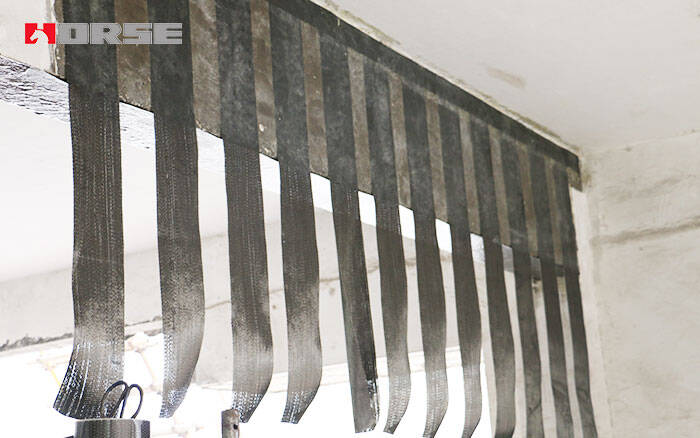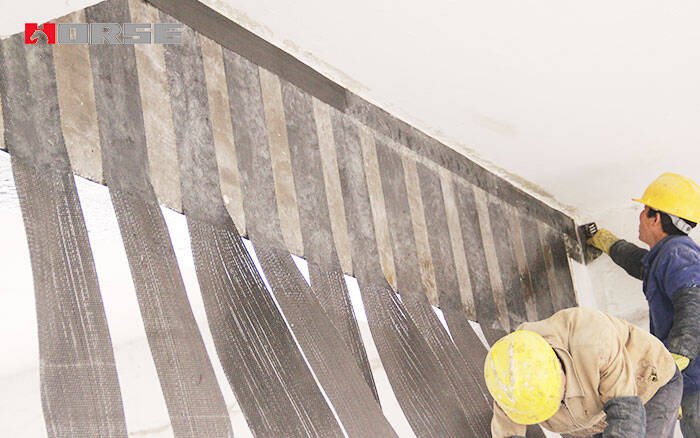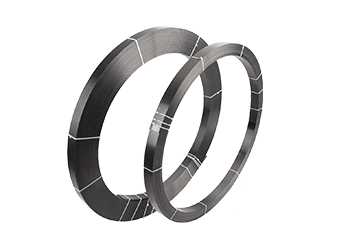Soluciones
La gama de negocios de construcción de caballos se extiende a todo el mundo y sirve a miles de clientes con productos, orientación técnica especializada en construcción, y somos testigos del reinicio de la marca china con ellos.
La tecnología de refuerzo de fibra de carbono puede restaurar y mejorar la capacidad de carga y la capacidad de tráfico de la estructura antigua, prolongando la vida útil de la estructura.

La tecnología de refuerzo de fibra de carbono con unión externa es un nuevo tipo de tecnología de refuerzo estructural. La fibra de carbono (CFRP) es un tipo de lámina compuesta reforzada estructuralmente, que está hecha de fibra de carbono de alta resistencia a la tracción impregnada con resina epoxi. Utiliza resina epoxi como aglutinante y se adhiere al miembro dañado a lo largo de la dirección de la fuerza o perpendicular a la dirección de la grieta. Como medio de unión por cizallamiento entre ellos, el aglutinante forma un nuevo complejo, que hace que el parche de refuerzo y el refuerzo existente se unan, aumenta la resistencia a la tracción o al cizallamiento de la estructura, mejora eficazmente la resistencia, la rigidez, la resistencia a las grietas y la ductilidad de la estructura, y controla el desarrollo continuo de grietas y deflexiones.
1 Comparación de propiedades de diferentes materiales
Los diferentes materiales de refuerzo utilizados en el proyecto de análisis son sin duda materiales FRP, especialmente la tela hecha de telas CFRP, que tienen un rendimiento y uso superiores.
1) peso ligero y puede operar en espacios estrechos.
2) alta resistencia, aplicación flexible de refuerzo de flexión, aro cerrado y cortante.
3) componentes flexibles y complejos.
4) corrosión química y ambientes hostiles como resistencia alcalina;
5) la tela es plana y tiene poca influencia en la decoración.
6) larga vida útil y largo período de funcionamiento.
7) se permite la humedad ambiental antes, durante y después del funcionamiento.
8) aglutinante de alto módulo y alta resistencia.
9) su material base puede ser hormigón, mampostería, estructura de madera y otros materiales de construcción.
10) resistencia a altas temperaturas, resistencia a la corrosión y buen rendimiento sísmico.
11) resistencia a la fluencia bajo carga permanente;
12) tixotrópico y fácilmente soluble, que cumple con los requisitos de protección ambiental. La comparación cuantitativa de varios materiales se muestra en la Tabla 1.
| Propiedades físicas | Fibra de carbono | Acero de grado dos ordinario | Barra de acabado | hilo de acero | Alambre de acero al carbono |
| Resistencia a la tracción (Mpa) | 3450-3500 | 340 | 835-1000 | 1440 | 1520 |
| Módulo de elasticidad (Mpa) | 215-234 | 200 | 210 | 190 | 200 |
| Densidad (g/cm3) | 1.88 | 7.388 | 7.88 | 7.88 | 7.88 |
Alargamiento(%) | 1.5 | 10 | 7-10 | 4 | 4 |
En comparación con otros materiales de refuerzo, el CFRP tiene un módulo elástico más alto, una mayor elasticidad a la tracción y una gravedad específica más pequeña.
2 Comparación de economía y eficiencia
La inversión única en el refuerzo de CFRP puede reducir el trabajo de mantenimiento básico al menos a la mitad en comparación con otros métodos de refuerzo, y el ciclo de mantenimiento puede prolongarse en gran medida, reduciendo así en gran medida el costo de mantenimiento. La durabilidad y la resistencia a la corrosión son índices importantes para evaluar la calidad de una ingeniería estructural. Especialmente para algunos edificios con requisitos especiales, como los edificios costeros, los edificios que a menudo se erosionan por un entorno químico adverso (plantas químicas) y algunos edificios que se erosionan por la radiación (edificios de plantas de energía nuclear y contenedores de almacenamiento de desechos nucleares), la anticorrosión y la antirradiación (antienvejecimiento) se convierten en consideraciones importantes en dicho diseño estructural. Por lo tanto, estamos muy preocupados por la durabilidad de los materiales de fibra de carbono y sus compuestos.
Como la fibra de carbono es un tipo de material de alta tecnología, se ha utilizado en el campo de la ingeniería civil durante poco tiempo y los datos medidos son muy pocos. Sin embargo, las materias primas de fibra de carbono tienen una excelente durabilidad. Los resultados de las pruebas de durabilidad y los estudios experimentales relacionados con la tela de fibra de carbono y sus compuestos en Japón también prueban los siguientes puntos de vista. En un entorno débilmente ácido, después de un cierto número de ciclos de congelación y descongelación, después de un cierto número de alternancia seco-húmedo, después de un cierto tiempo de luz, sumergido en agua a 70 °C durante 30 días, la unión entre CFRP y hormigón no ha disminuido, y la durabilidad es muy buena. Después de 100 ciclos térmicos (+20 20 °C), la capacidad de carga de CFRP no ha disminuido. Las observaciones de campo (incluidas 168 horas de observaciones de deformación continua) y los resultados de las pruebas de un puente reforzado con láminas de CFRP en Japón muestran que la fuerza de unión entre las láminas de CFRP y el hormigón no ha disminuido, y es mayor que la resistencia a la tracción del propio hormigón, y la capacidad de carga no ha disminuido.
La tela de fibra de carbono y su compuesto con material de unión tienen buena resistencia a la corrosión en diversas condiciones ambientales, y pueden resistir la corrosión ácida, alcalina, salina y atmosférica que se encuentra a menudo en los edificios. También tiene buena resistencia a la fatiga. El propio CFRP puede desempeñar un papel protector de la estructura interna de hormigón, mejorando en gran medida la durabilidad de la propia estructura de hormigón, desempeñando un papel doble de refuerzo y reparación. Una vez completado el refuerzo, se pueden tomar algunas medidas de protección para cumplir con los requisitos de ingeniería.

3. El mecanismo de CFRP y acero aglomerado es similar al del acero aglomerado. Las características y ventajas de CFRP y acero aglomerado se muestran en la tabla.
Método de refuerzo | Reforzado con chapa de acero | Reforzado con CFRP |
Mecanismo de refuerzo | Ambos son básicamente iguales. Ambos utilizan materiales de unión de resina para pegar materiales de refuerzo sobre la superficie del hormigón con el fin de lograr el propósito de reforzar los elementos estructurales. | |
Propiedades de los materiales de refuerzo | Acero 3: Resistencia a la tracción: 210 MPa Módulo de elasticidad: 2,1 x 105 MPa Isotropía | Resistencia a la tracción: 2000 MPa~3 550 MPa Módulo elástico: 2,35 x 105 MPa Tracción unidireccional |
Rendimiento de trabajo conjunto con hormigón | La unión no es suficiente mediante un adhesivo estructural y anclado con pernos. | Tres tipos de materiales de unión: 1) resina sumergida en la capa superficial del hormigón; 2) material de nivelación para reparar desniveles locales; 3) resina sumergida desde la fibra entre la infiltración de haces de fibras completamente envueltos en un todo compuesto, buen rendimiento de trabajo conjunto. |
Influencia en la estructura original | El espesor de la primera capa es de 3 mm a 6 mm y la calidad de cada capa es de 23,7 kg/m2 a 47,2 kg/m2. | El espesor de la primera capa es de 0,5 mm a 0,6 mm y la calidad de cada capa es de 500 g/m2 a 600 g/m2. |
Eficiencia de construcción | Si la placa de acero se corta con antelación, será difícil cortar el material en un tamaño irregular, por lo que es difícil que coincida con la estructura real. Debido a su gran rigidez, el área de unión efectiva es difícil de alcanzar el nivel en el que se puede pegar la fibra de carbono y es difícil remediar la cavidad. Es necesario sujetar agujeros o abrazaderas para pegar. | Se puede cortar en el lugar de acuerdo con el tamaño real y se puede utilizar para refuerzo de forma irregular. No necesita maquinaria grande, es ligero y suave, fácil de colocar. El área de unión efectiva puede alcanzar más del 95%. |
Aplicable | Solo se aplica a tipos estructurales simples. | Se aplica ampliamente al refuerzo y reparación de varios tipos estructurales, varias formas estructurales, incluidas superficies curvas y nodos complejos. |
Durabilidad | En el caso de las estructuras exteriores de gran longitud, la tasa de conducción térmica de la placa de acero y el hormigón es más de 30 veces diferente, y la deformación de la placa de acero y el hormigón no es sincronizada bajo la acción de la temperatura, lo que provoca la falla de la capa de unión. La placa de acero en sí misma es fácil de oxidar y necesita un mantenimiento regular. | Los materiales de fibra de carbono tienen una excelente durabilidad y son resistentes a la corrosión ácida, alcalina, salina, atmosférica y ambiental. |
Límite de tiempo | Más largo | Short, 1/2 of bonded steel reinforcement. |
Costos de mantenimiento | Los costos de mantenimiento posteriores son más altos | Los costes de mantenimiento posteriores son bajos. |
5 Conclusión
La tecnología de refuerzo de fibra de carbono puede restaurar y mejorar la capacidad de carga y la capacidad de tráfico de la estructura antigua, prolongar la vida útil de la estructura, satisfacer las necesidades de uso posterior, no solo eliminar los peligros ocultos de la seguridad estructural, consolidar el uso de funciones, sino también ahorrar una gran cantidad de inversión y puede recibir buenos beneficios sociales y económicos.
Puede encontrar cualquier cosa que necesite, confíe en probar estos productos y encontrará la gran diferencia después de eso.

Tejido de fibra de carbono unidireccional de alta resistencia para refuerzo de compuesto de polímero reforzado con fibra (FRP).

Impregnación y pasta de componentes reforzados de superficie y productos de fibra.

Lámina de fibra de carbono pultruída para reforzamiento de estructuras